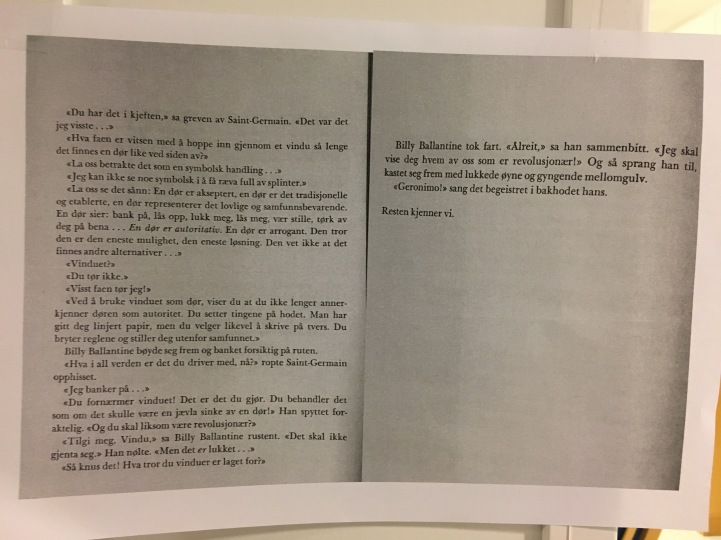Books finished in February:
(Warning: reviews are unpolished and quickly written.)
Dune (1965) by Frank Herbert. Classic soft science fiction, with focus on politics, some economics, intrigue and personal relationships, even though we are in space. Clever, cynical use of religions and mysticism. Even if one thinks it too fantastic and mystic, one has to appreciate its grand epicness. According to Wikipedia, Dune is claimed to be the best-selling science fiction novel in history. Not sure I will follow up on the whole saga (five more books by Herbert, then 13 more by Brian Herbert and Kevin J. Anderson), but this first one is definitely recommended.
Jonathan Livingston Seagull (1970) by Richard Bach. Jonathan Livingston Seagull is not like the others of his Flock, he does not care for shrieking and fighting for every breadcrumb from the fishing boats, but rather spends his time learning more about and perfecting his flight. Inspirational? Yes. Banal? I do not think so. I remember I liked the book as a kid, and now reading it to my son I still found it enjoyable. The book has received a lot of bad reviews and critiques for being shallow and too simple. Of course self-improvement and following one’s passion are not the only values in life, but they are still important concepts, and any way the story also focuses e.g. on helping others. And Jonathan’s passion – flight – even has practical applications. Some passages may appear with a religious tone, butI think the book has more in common with fantasy, perhaps because there is no subordination to a god, just some fantastical elements.
The Undoing Project: A Friendship That Changed Our Minds (2016) by Michael Lewis. The friendship between and work of Daniel Kahneman and Amos Tversky. The intense, personal relationship between the outgoing, charismatic polymath Tversky and the reserved, self-critical, uncertain Kahneman is the red thread running through the book, and perhaps receives a bit too much attention, in my opinion. But their work, which arguably launched the field known as behavioral economics is also present. Mostly on how people, dumb and smart, layperson and expert, make systematic errors in reasoning. The book is inevitably somewhat asymmetric in that it contains a lot of commentary by Kahneman, but not Tversky, who died of cancer in 1996. I was prepared to mention Kahneman as a fallen hero, after his unthinking denial of the critique of priming studies in Thinking fast and slow, but true to how he is described in the book, he has now publicly admitted his error.
Den som har begge beina på jorda står stille. Eller: Alveolene kommer! (1974) by Tor Åge Bringsværd. Background: The window of my office fell out for some reason. This reminded my colleague Ole Røgeberg of a passage from an old book by Norwegian author Tor Åge Bringsværd about the authoritarianism of doors and how one should rather enter through windows as a protest. Naturally, I had to go look up that passage. It is on pages 83-84:
The book itself, a novel dealing with anarchist themes, is way too digression based for me, but the door-window passage is fantastic.
Deep Work: Rules for Focused Success in a Distracted World (2016) by Cal Newport. Deep work: “Professional activities performed in a state of distraction-free concentration that push your cognitive capabilities to their limit. These efforts create new value, improve your skill, and are ard to replicate.” Shallow work: “Noncognitively demanding, logistical-style tasks, often performed while distracted. These efforts tend to not create new value in the world and are easy to replicate.” Stated like this, few would argue about the value and desirability of deep work. The hard part is actually doing it.
The first part of the book is about the value of deep work and how its conditions are deteriorating for modern knowledge workers, largely because of electronic communication and social media.
I was also already convinced about the importance of committing to and planning for deep work, which is what the second part of the book is about, but it helps hearing someone else say it clearly too. Part 2 is organized under the headings of four general “Rules”: 1 Work deeply, 2 Embrace boredom, 3 Quit social media, 4 Drain the shallows. That is fine, but more helpful are the small practical tips that are scattered in the text, such as: scheduling time for distraction-free deep work time, possibly amounting to a certain number of hours each day/week/month; set a fixed, relatively small quota for shallow work and schedule also that time; related, schedule time for internet/phone/email, etc., and for surprises/delays; keeping (visual) track of deep work time or small achievements; formally shutting down the workday at some point; practice concentration/focus with a hobby such as memorization, chess, etc. The tips are not always consistent, such as taking braks and constantly think about a hard problem while doing other things, but I think that is ok, everyone needs to experiment and find what works for them. Recommended if you, like me, need a push, but it should also be possible to just do it.
Ratings and previous books are in the library.
